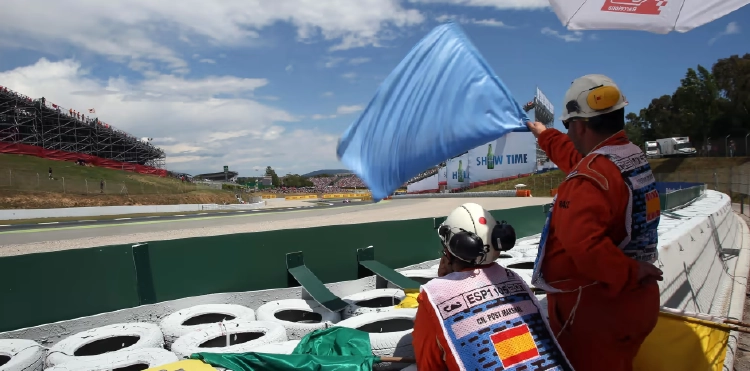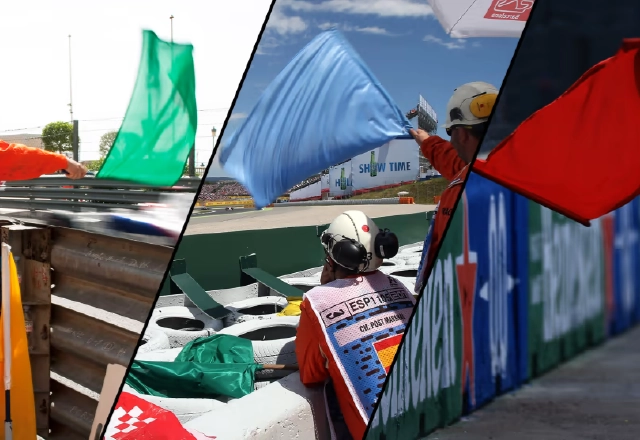As Formula One drivers race around the world at lightning speeds, they have a lot to consider. One of the things they need to understand is the meaning of the flags displayed by trackside marshals, which indicate various situations from accidents to debris on the circuit. To assist beginners, we have compiled a comprehensive list of all the flags that will be displayed throughout the season.
Formula 1 Flags : The Beginner’s Guide
Green Flag
As per Formula 1 Flags, To begin with, the green flag is a simple one. It is used to signal that the track is clear, whether it’s at the start of a warm-up lap, practice session, qualifying session, or immediately after an incident that required the use of one or more yellow flags.
Blue Flag
The blue flag is typically used to notify a driver that they are about to be overtaken. However, during the race, it has a slightly different connotation than in earlier sessions throughout the weekend.
At All Times:
The purpose of displaying this flag is to alert a driver exiting the pits that there is incoming traffic.
During Practice:
This flag is displayed to notify a driver that a faster car is in close proximity and is about to pass them.
During The Race:
As per Formula 1 Flags, This signal is displayed to a driver who is about to be overtaken by a faster car. The driver must allow the following car to pass as soon as possible. If the driver ignores this signal three times, they will receive a penalty.
White Flag
In Formula 1 Flags Rules, The white flag is used to signal to the driver that there is a significantly slower vehicle ahead. This flag is sometimes displayed at the end of practice sessions when drivers are practicing their starts.
Yellow Flag With Red Stripes
When there is a decrease in grip levels on the track due to oil or water, a stationary, striped yellow/red flag is displayed to notify the drivers.
Yellow Flag
In simple terms, the yellow flag is a warning signal of potential danger and can be displayed to drivers in two different ways:
Single Waved:
As per Formula 1 Flags, When the yellow flag is displayed, drivers are required to decrease their speed, refrain from overtaking, and be ready to alter their course due to a hazard on or near the track. It is essential that the driver visibly reduces their speed in the relevant sector/s.
Double Waved:
As per the guidelines, drivers are required to decrease their speed considerably, refrain from overtaking, and be ready to alter their course or halt if there is an obstacle that is obstructing the track partially or entirely, or if marshals are operating on or near the track.
In the free practice and qualifying sessions, it is essential to ensure that the driver has not made an effort to establish a significant lap time. If they have, they should abandon the lap, but it does not necessarily mean that they have to return to the pit lane. They can continue on the track if it is clear on the following lap.
‘Code 60’ Flag
As per Formula 1 Flags, There may be instances where the Clerk of the Course or Race Director decides to enforce a speed limit throughout the entire track or a specific section of the track when double yellow flags are exhibited during practice sessions, qualifying sessions, or races.
When a single speed limit is enforced around the entire track, it will be signaled by a single yellow flag and a board displaying ‘FCY’ (Full Course Yellow), or a purple flag with a white circle containing the number 60, which is commonly referred to as ‘Code 60.’ This speed limit sets a maximum speed of 60 km/h.
As per Formula 1 Flags, When a variable speed limit is enforced, it will be signaled by a single yellow flag and a board labeled VSC (Virtual Safety Car). If a speed limit is imposed on a specific section of the track, the beginning and end of the zone will be marked with a double yellow flag and a board labeled ‘SLOW.‘

Red Flag
In Formula 1 Flags, At the beginning of a practice session, qualifying session, or race, a red flag is waved at the start line and each marshal post around the circuit. This indicates that officials have decided to stop the session for various reasons, such as a serious incident or poor weather conditions.
During practice and qualifying, drivers must slow down and proceed back to their pit garages. In the race, drivers must also reduce their speed and proceed slowly to the pit lane. They must then line up at the exit and wait for further instructions.
Black Flag
As per Formula 1 Flags, When a driver is disqualified and needs to return to their pit garage immediately, the black flag is used. The stewards are solely responsible for making the decision to display this flag.
Black Flag With An Orange Disc
If a driver’s car has mechanical issues that could endanger themselves or others, they will be notified with a black flag with an orange circle. This flag indicates that the driver must stop in the pits as soon as possible.
Once the mechanical issues have been resolved to the chief scrutineer’s satisfaction, the car can resume the race. If not, it will have to stay in the pits.
Black And White Flag
When a driver is reported for unsportsmanlike behaviour, they are shown the black and white flag as a warning. The driver’s race number is displayed alongside the flag, which also applies to the black flag and black flag with an orange disc above.
Chequered Flag
As per Formula 1 Flags, To signify the end of any practice session, qualifying session, or race, the black and white chequered flag is waved from above the pit wall. The flag is waved until all competing cars have reached it.
Flag Panels
As per Formula 1 Flags, To ensure that messages are clear for drivers, digital light panels are installed around all F1 circuits in addition to marshalls displaying flags trackside. These panels take into account day and night events as well as changeable weather conditions, as shown in the video above.
Get IPL 2023 Live Score along with Points Table & Schedule Updates at IceCric.News and Follow for Live Updates – Twitter, Facebook & Instagram.




